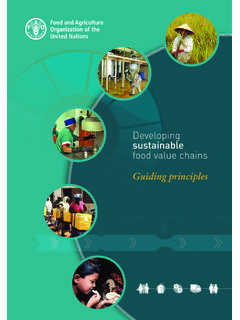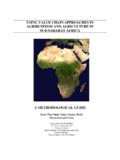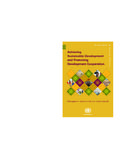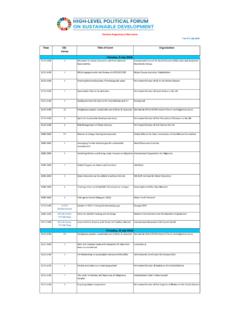Transcription of Rising Global Interest in Farmland - World Bank
1 Klaus Deininger and Derek Byerlee with Jonathan Lindsay, Andrew Norton,Harris Selod, and Mercedes SticklerRising Global Interest in Farmland CAN IT YIELD sustainable AND EQUITABLE BENEFITS?AGRICULTURE AND RURAL DEVELOPMENTRISING Global INTERESTIN FARMLANDS eventy-five percent of the World s poor live in rural areas, and most are involved inagriculture. In the 21st century, agriculture remains fundamental to economic growth,poverty alleviation, and environmental sustainability. The World Bank s Agriculture andRural Development publication series presents recent analyses of issues that affect the roleof agriculture, including livestock, fisheries, and forestry, as a source of economic develop-ment, rural livelihoods, and environmental services. The series is intended for practicalapplication, and we hope that it will serve to inform public discussion, policy formulation,and development in this series:Agribusiness and Innovation Systems in AfricaAgricultural Land Redistribution: Toward Greater ConsensusAgriculture Investment SourcebookBioenergy Development: Issues and Impacts for Poverty and Natural Resource ManagementBuilding Competitiveness in Africa s Agriculture: A Guide to Value Chain Concepts andApplicationsChanging the Face of the Waters: The Promise and Challenge of sustainable AquacultureEnhancing Agricultural Innovation: How to Go Beyond the Strengthening of Research SystemsForests Sourcebook: Practical Guidance for Sustaining Forests in Development CooperationGender and Governance in Rural Services: Insights from India, Ghana, and EthiopiaGender in Agriculture SourcebookOrganization and Performance of Cotton Sectors in Africa.
2 Learning from Reform ExperienceReforming Agricultural Trade for Developing Countries, Volume 1: Key Issues for a Pro-Development Outcome of the Doha Round Reforming Agricultural Trade for Developing Countries, Volume 2: Quantifying theImpact of Multilateral Trade ReformRising Global Interest in Farmland : Can It Yield sustainable and Equitable Benefits?Shaping the Future of Water for Agriculture: A Sourcebook for Investment in AgriculturalWater ManagementThe Sunken Billions: The Economic Justification for Fisheries ReformSustainable Land Management: Challenges, Opportunities, and Trade-OffsSustainable Land Management SourcebookSustaining Forests: A Development StrategyAGRICULTURE AND RURAL DEVELOPMENTCan It Yield sustainable and Equitable Benefits?Klaus Deininger and Derek Byerleewith Jonathan Lindsay, Andrew Norton,Harris Selod, and Mercedes SticklerRISING Global INTERESTIN Farmland 2011 The International Bank for Reconstruction and Development/TheWorld Bank1818 H Street NWWashington DC 20433 Telephone: 202-473-1000 Internet: rights reserved1 2 3 4 13 13 12 11 This volume is a product of the staff of the International Bank for Reconstructionand Development/The World Bank.
3 The findings, interpretations, and conclusionsexpressed in this volume do not necessarily reflect the views of the Executive Direc-tors of The World Bank or the governments they World Bank does not guarantee the accuracy of the data included in thiswork. The boundaries, colors, denominations, and other information shown onany map in this work do not imply any judgement on the part of The World Bankconcerning the legal status of any territory or the endorsement or acceptance ofsuch and PermissionsThe material in this publication is copyrighted. Copying and/or transmitting por-tions or all of this work without permission may be a violation of applicable International Bank for Reconstruction and Development / The World Bankencourages dissemination of its work and will normally grant permission to repro-duce portions of the work permission to photocopy or reprint any part of this work, please send arequest with complete information to the Copyright Clearance Center Inc.
4 , 222 Rosewood Drive, Danvers, MA 01923, USA; telephone: 978-750-8400; fax: 978-750-4470; Internet: other queries on rights and licenses, including subsidiary rights, should be addressed to the Office of the Publisher, The World Bank, 1818 H Street NW,Washington, DC 20433, USA; fax: 202-522-2422; e-mail: 978-0-8213-8591-3eISBN: 978-0-8213-8592-0 DOI: of Congress Cataloging-in-Publication DataDeininger, Klaus W., 1962- Rising Global Interest in Farmland : can it yield sustainable and equitable benefits?/ Klaus Deininger and Derek cm. (Agriculture and rural development)Includes bibliographical references and 978-0-8213-8591-3 ISBN 978-0-8213-8592-0 (electronic)1. Land use. 2. Land tenure Government policy. 3. Right of property. I. Byerlee,Derek. II. World Bank. III. dc222010044273 Cover photo:Klaus DeiningerCover design:Critical StagesvCONTENTSP refacexiiiAbout the AuthorsxviiAcknowledgmentsxxiAbbreviatio nsxxiiiOverviewxxvIntroduction1 Notes7 References71.
5 Land Expansion: Drivers, Underlying Factors, and Key Effects9 Past and Likely Future Patterns of Commodity Demand and Land Expansion10 Future Demand for Agricultural Commodities and Land13 Lessons from Past Processes of Land Expansion: Regional Perspectives16 Factors Affecting the Organization of Agricultural Production28 Can Large-Scale Investment Create Benefits for Local Populations?34 Conclusion41 Notes43 References442. Is the Recent Land Rush Different?49 Evidence from Media Reports50 Evidence from Country Inventories56 Evidence from Project Case Studies64 Conclusion70 Notes72 References733. The Scope for and Desirability of Land Expansion75 Methodology and Potential Availability of Land for Rainfed Crop Production77 Adopting a Commodity Perspective83 Toward a Country Typology86 Conclusion92 Notes93 References944. The Policy, Legal, and Institutional Framework95 Respect for Existing Property Rights to Land and Associated Natural Resources98 Voluntary and Welfare-Enhancing Nature of Land Transfers104 Economic Viability and Food Security109 Impartial, Open, and Cost-Effective Mechanisms to Implement Investments114 Environmental and Social Sustainability119 Conclusion125 Notes126 References1275.
6 Moving from Challenge to Opportunity 129 Key Areas for Action by Governments130 Investors133 Civil Society137 International Organizations138 Conclusion: The Need for an Evidence-Based Multistakeholder Approach141 Notes143 References144 Appendix 1: Methodology of and Issues Encountered in Collecting Inventory Data145 Cambodia145 Democratic Republic of Congo146 Ethiopia146 Indonesia147 Liberia147viCONTENTSLao People s Democratic Republic148 Mozambique148 Nigeria149 Pakistan149 Paraguay150 Peru150 Sudan151 Ukraine151 Zambia152 Notes152 References153 Appendix 2: Tables155 Appendix 3: Figures181 Appendix 4: Maps187 Contributors195 Index199 CONTENTS viiviiiBOXES, FIGURES, AND TABLESB oxes1 Principles for Responsible Agro-Investmentxxvii2 Using Auctions to Transfer Public Land in Peru s Coastal Demands Land? Crop Yields Stagnating? Land Markets in Latin Smallholders and Large Farms Coexist? for Engaging Small Is the Right Price for Land? of Land Concessions in the Lao People s Democratic and Valuing Indirect Impacts of Land Cover of the Policy, Legal, and Institutional Framework Assessment in Auctions to Transfer Public Extractive Industries Transparency Initiative139 Figures1 Potential Land Availability vs.
7 Potential for Increasing Yieldsxxxvi2 Yield Gap, Availability of Uncultivated Land, and Area Cultivated per Rural Inhabitant, Selected Countries in Sub-Saharan Africaxxxviii3 Yield Gap, Availability of Uncultivated Area, and Area Cultivated per Rural Inhabitant for Selected Countries in Latin America and the Expansion and Yield Expansion, Deforestation in Mato Grosso, Brazil, 2001 of Returns to Oil Palm and Potential REDD Payments for Forest Conservation in on Semi-Mechanized Farms, Sudan, 1970 Production Costs by of United States Farm Size and Nonfarm Manufacturing Commodity Prices and Number of Media Reports on Foreign Land Distribution of Projects and Total Land Area by Destination Region and Commodity of Projects by Commodity and Production Status of Gaps and Relative Land Availability for Different Gaps and Relative Land Availability for South Asia,East Asia and Pacific, and the Middle East and North Gaps and Relative Land Availability for Latin America and the Gaps and Relative Land Availability for Eastern Europe and Central Gaps and Relative Land Availability for Sub-Saharan Africa91 Tables1 Large Land Acquisitions in Select Countriesxxxiii2 Potential Availability of Uncultivated Land in Different in Arable Area Used for Farming10ixBOXES, FIGURES, AND Commodities Driving Land Use Change, 1990 Farm Sizes and Operational Holding Sizes Listed Companies in Agribusiness Value and Cost Structure for Major Rice Factor Ratios in Case Studies of Large-Scale Expectation Values for Perennial Probability that a Country Is Targeted by Encountered in Collecting Inventory Land Acquisitions in Selected Countries, 2004 Insights from Case Supply of Land for Rainfed Cultivation in Different Area of Nonforested.
8 Nonprotected Land Close to Market Most Suitable for Different Crops under Rainfed Yield Relative to Estimated Potential Yield82 Appendix Sizes and Origin of Projects in Country for Country Selection and Key Insights from Case of Global Land Use for Food, Feed, Costs of Sorghum Production in of Analysis of Farm Incomes for Smallholders Relative to Wage Employment on Large-Scale Land Availability by Availability by Region for Different Potential for Land/Yield Expansion for Key Producers and Countries with Uncultivated Potential for Land/Yield Expansion for Key Producers and Countries with Uncultivated Soybeans Potential for Land/Yield Expansion for Key Producers and Countries with Uncultivated Land174xBOXES, FIGURES, AND Sugarcane Potential for Land/Yield Expansion for Producers and Countries with Uncultivated Oil Palm Potential for Land/Yield Expansion for Key Producers and Countries with Uncultivated Land177 Appendix Gap vs.
9 Relative Land Availability, Gap vs. Relative Land Availability, Europe and Central Gap vs. Relative Land Availability, Latin America and the Caribbean Gap vs. Relative Land Availability, North America,Northern Europe, and Gap vs. Relative Land Availability, Selected Countries186 Appendix Mozambique Concession Overlap with Community Maximum Potential Value of Output for Maximum Potential Value of Output for Latin America and the Maximum Potential Value of Output for Maximum Potential Value of Output for the Middle East and Maximum Potential Value of Output for Oceania193 BOXES, FIGURES, AND TABLES xixiiiPREFACEI nterest in Farmland is Rising . And, given commodity price volatility, grow-ing human and environmental pressures, and worries about food security,this Interest will increase, especially in the developing countries have suitable land available that is either not cultivated orproduces well below its potential.
10 This was a development challenge evenbefore the food price rise of 2008. Seventy-five percent of the World s poorare rural, and most are engaged in farming. The need for more and betterinvestment in agriculture to reduce poverty, increase economic growth, andpromote environmental sustainability was already clear when there were only 830 million hungry people before the food price rise. The case is evenclearer today when, for the first time in human history, over a billion peoplego to bed hungry each of the highest development priorities in the World must be to improvesmallholder agricultural productivity, especially in Africa. Smallholder pro-ductivity is essential for reducing poverty and hunger, and more and betterinvestment in agricultural technology, infrastructure, and market access forpoor farmers is urgently needed. When done right, larger-scale farming systemscan also have a place as one of many tools to promote sustainable agriculturaland rural development, and can directly support smallholder productivity, forexample, through outgrower programs.
















